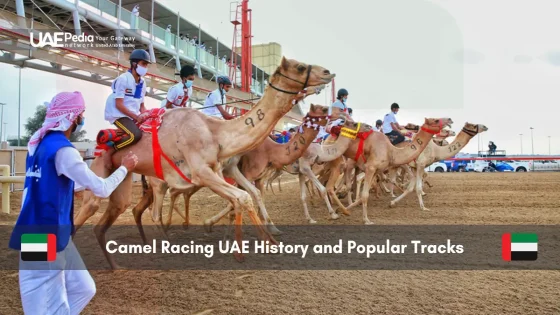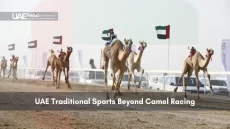What if we told you a sport born from Bedouin storytelling circles now draws crowds of 20,000+ spectators? Camel racing in the United Arab Emirates isn’t just a competition—it’s a living bridge between windswept dunes and air-conditioned stadiums.
This ancient tradition traces back over 1,400 years, when tribes gathered to celebrate speed and endurance. Today, it’s evolved into a high-tech spectacle where robotic jockeys steer prized hejin (race camels) at 40 mph. The UAE’s modern tracks mirror this duality: sand-blown heritage meets LED finish lines.
We’ll explore how camel racing became the Middle East’s most unexpected cultural crossover. From moonlit desert races to Dubai’s multimillion-dirham events, you’ll discover:
- How 7th-century social rituals shaped today’s championship circuits
- The role of AI trainers and heritage preservation programs
- Must-visit tracks where tradition gallops alongside innovation
Grab your ghutra—we’re stepping into a world where hoofbeats sync with smartphone alerts.
The Rich History of Camel Racing in the UAE
Imagine a sport where the cheers of ancient tribes still echo across modern stadiums. Long before skyscrapers dotted the horizon, Bedouin communities gathered in desert clearings to celebrate life’s milestones through spirited contests. These events weren’t just races—they were living storybooks where endurance and speed became communal pride.
Traditional Roots and Cultural Significance
Early races began as informal tests of skill during weddings and Eid celebrations. Picture this: clans arriving with their fastest hejin, children perched on shoulders, elders placing friendly bets with dried dates. Distances rarely exceeded 500 meters—more about shared joy than stopwatch precision.
| Century | Key Developments | Race Details |
|---|---|---|
| 7th-10th | Bedouin festival races | 300-500m sprints |
| 16th-18th | Trade route endurance challenges | Multi-day events |
| Early 20th | Formal competition rules emerge | 1-4km distances |
From Folk Sport to Competitive Tradition
By the 1930s, what started as village fun became serious business. Tribal leaders began standardizing routes and training methods. Races transformed into showcases of breeding prowess, with prized animals representing family honor. This shift paved the way for today’s regulated circuits—where heritage gallops hand-in-hoof with innovation.
Camel racing UAE: The Modern Era
Picture a racetrack where whirring gears harmonize with thundering hooves—welcome to camel racing’s 21st-century revolution. The sport’s most radical transformation began in 2002 when human rights concerns led to a groundbreaking decision: replacing child riders with lightweight robot jockeys. This pivot didn’t just modernize competitions—it redefined them.
Remote Controls Replace Reins
Swiss-engineered robots weighing under 4 pounds now perch atop racing camels, controlled via walkie-talkies by owners in chase cars. These high-tech riders carry:
- GPS trackers mapping speed patterns
- Solar-powered whips responding to voice commands
- Cameras streaming real-time footage to trainers
The shift erased ethical dilemmas while boosting speeds—today’s champions hit 40 mph, their biometrics monitored like Formula 1 cars.
Rules Rewritten, Legacy Preserved
Modern competitions follow strict guidelines ensuring fairness:
| Camel Age | Race Distance | Breed Class |
|---|---|---|
| 2-4 years | 2-4 km | Local Asayel |
| 5-8 years | 6-10 km | Hybrid Majahim |
Trainers now use AI-powered treadmills and climate-controlled stables, blending Bedouin wisdom with data science. As one breeder told us: “We honor the past by racing smarter—not harder.”
This fusion of innovation and heritage keeps the centuries-old tradition thriving. From solar-powered starting gates to live-streamed races, every upgrade ensures camels and participants get safer, fairer, and more thrilling events. The desert’s heartbeat just got a tech-powered rhythm section.
Popular Camel Racing Tracks and Events
Ready to trade stadium seats for sand dunes? The UAE’s racetracks transform arid landscapes into adrenaline hubs every race season. Two venues stand out: Al Marmoom’s golden waves and Al Khawaneej’s urban-edge oval. Weekend mornings here buzz with owners fine-tuning robots and trainers analyzing hoof sensors.
Duel of the Dunes: Iconic Venues
Al Marmoom’s 10km track near Bab Al Shams hosts Friday showdowns where racing camels streak across dawn-lit sands. Thirty minutes west, Al Khawaneej’s floodlit circuit runs evening sprints visible from Emirates Road. Both offer:
- Free admission with shaded grandstands
- Food trucks serving cardamom coffee and dates
- Kid zones with camel petting areas
Festivals Where Heritage Gallops
October’s Heritage Cup at Al Wathba draws 15,000 fans for weeklong festivals. Champions win jeweled daggers, while visitors enjoy:
| Event | Highlight | Prize |
|---|---|---|
| Golden Sword Race | 8km endurance test | Handcrafted blades |
| Young Breeders Show | Juvenile camel parades | Silver trophies |
Your Race Day Playbook
Arrive by 6:30 AM for prime seating as jockeys get calibrated. Races alternate between 4km sprints (under 7 minutes) and 10km marathons. One trainer whispered: “Watch lane 3—that’s where speed specialists usually break ahead.” Post-race, chat with handlers at the stables—many love sharing training hacks over Arabic sweets.
Final Perspectives on Camel Racing and Its Future
Where robot jockeys and tradition collide, the future of this desert-born sport takes shape. What began as Bedouin bonding rituals now thrives as a cultural touchstone—one where AI trainers analyze hoof patterns and solar-powered whips crack under dawn skies. The Emirates’ blend of reverence and innovation keeps competitions fresh while honoring centuries of heritage.
Tomorrow’s races may see holographic starting gates and global streaming partnerships. Regulatory shifts around animal welfare and jockey tech already reshape event formats, mirroring changes seen in horse racing circles. Yet community remains key—owners still swap breeding secrets over karak chai, their passion bridging generations.
As international audiences discover these events, expect tighter age limits and smarter weight rules to emerge. The region’s commitment to balancing progress with preservation sets a template other countries watch closely. Want to stay ahead? Bookmark race calendars and follow rule updates—this sport gallops faster than you’d expect.
From moonlit dunes to LED-lit tracks, the journey continues. Challenges exist, but so does determination. Here, every thundering stride writes a new chapter in an ancient story—one we’re all invited to read.
Most begin training around 2-3 years old, with peak performance between 6-12 years. Owners prioritize health checks and gradual conditioning to build endurance for desert tracks.
To address human rights concerns, the UAE banned underage jockeys in 2005. Remote-controlled robots—weighing under 4.4 lbs—now guide camels via voice commands and GPS, blending tradition with tech innovation.
Elite camels hit 25-40 mph, depending on breed and distance. Shorter sprints (2-4 km) favor explosive speed, while longer races (8-10 km) test stamina—similar to thoroughbred strategies in horse sports.
Al Marmoom Heritage Village near Dubai and Al Wathba in Abu Dhabi host winter season events (Oct-Mar). Check local schedules—races often start at dawn, with free entry and Arabic coffee served trackside!
Gambling isn’t permitted, but owners compete for prestige and prizes like luxury cars or golden swords. The focus stays on heritage preservation, with camel beauty pageants often held alongside races.
Custom diets (dates, alfalfa), treadmill sessions, and swimming pools build fitness. Some stables use AI trackers to monitor vitals—proving even desert traditions embrace 21st-century smarts.

















